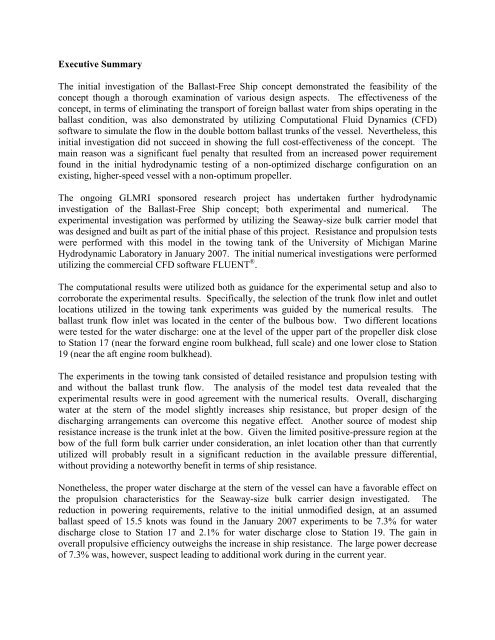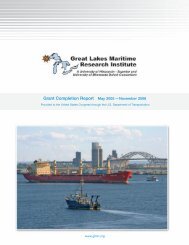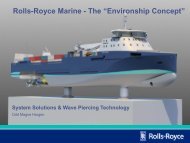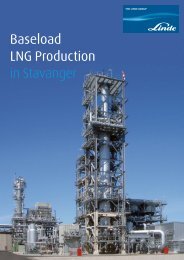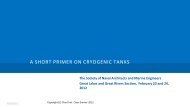Further Development and Optimization of the Ballast-Free Ship ...
Further Development and Optimization of the Ballast-Free Ship ...
Further Development and Optimization of the Ballast-Free Ship ...
You also want an ePaper? Increase the reach of your titles
YUMPU automatically turns print PDFs into web optimized ePapers that Google loves.
Executive Summary<br />
The initial investigation <strong>of</strong> <strong>the</strong> <strong>Ballast</strong>-<strong>Free</strong> <strong>Ship</strong> concept demonstrated <strong>the</strong> feasibility <strong>of</strong> <strong>the</strong><br />
concept though a thorough examination <strong>of</strong> various design aspects. The effectiveness <strong>of</strong> <strong>the</strong><br />
concept, in terms <strong>of</strong> eliminating <strong>the</strong> transport <strong>of</strong> foreign ballast water from ships operating in <strong>the</strong><br />
ballast condition, was also demonstrated by utilizing Computational Fluid Dynamics (CFD)<br />
s<strong>of</strong>tware to simulate <strong>the</strong> flow in <strong>the</strong> double bottom ballast trunks <strong>of</strong> <strong>the</strong> vessel. Never<strong>the</strong>less, this<br />
initial investigation did not succeed in showing <strong>the</strong> full cost-effectiveness <strong>of</strong> <strong>the</strong> concept. The<br />
main reason was a significant fuel penalty that resulted from an increased power requirement<br />
found in <strong>the</strong> initial hydrodynamic testing <strong>of</strong> a non-optimized discharge configuration on an<br />
existing, higher-speed vessel with a non-optimum propeller.<br />
The ongoing GLMRI sponsored research project has undertaken fur<strong>the</strong>r hydrodynamic<br />
investigation <strong>of</strong> <strong>the</strong> <strong>Ballast</strong>-<strong>Free</strong> <strong>Ship</strong> concept; both experimental <strong>and</strong> numerical. The<br />
experimental investigation was performed by utilizing <strong>the</strong> Seaway-size bulk carrier model that<br />
was designed <strong>and</strong> built as part <strong>of</strong> <strong>the</strong> initial phase <strong>of</strong> this project. Resistance <strong>and</strong> propulsion tests<br />
were performed with this model in <strong>the</strong> towing tank <strong>of</strong> <strong>the</strong> University <strong>of</strong> Michigan Marine<br />
Hydrodynamic Laboratory in January 2007. The initial numerical investigations were performed<br />
utilizing <strong>the</strong> commercial CFD s<strong>of</strong>tware FLUENT ® .<br />
The computational results were utilized both as guidance for <strong>the</strong> experimental setup <strong>and</strong> also to<br />
corroborate <strong>the</strong> experimental results. Specifically, <strong>the</strong> selection <strong>of</strong> <strong>the</strong> trunk flow inlet <strong>and</strong> outlet<br />
locations utilized in <strong>the</strong> towing tank experiments was guided by <strong>the</strong> numerical results. The<br />
ballast trunk flow inlet was located in <strong>the</strong> center <strong>of</strong> <strong>the</strong> bulbous bow. Two different locations<br />
were tested for <strong>the</strong> water discharge: one at <strong>the</strong> level <strong>of</strong> <strong>the</strong> upper part <strong>of</strong> <strong>the</strong> propeller disk close<br />
to Station 17 (near <strong>the</strong> forward engine room bulkhead, full scale) <strong>and</strong> one lower close to Station<br />
19 (near <strong>the</strong> aft engine room bulkhead).<br />
The experiments in <strong>the</strong> towing tank consisted <strong>of</strong> detailed resistance <strong>and</strong> propulsion testing with<br />
<strong>and</strong> without <strong>the</strong> ballast trunk flow. The analysis <strong>of</strong> <strong>the</strong> model test data revealed that <strong>the</strong><br />
experimental results were in good agreement with <strong>the</strong> numerical results. Overall, discharging<br />
water at <strong>the</strong> stern <strong>of</strong> <strong>the</strong> model slightly increases ship resistance, but proper design <strong>of</strong> <strong>the</strong><br />
discharging arrangements can overcome this negative effect. Ano<strong>the</strong>r source <strong>of</strong> modest ship<br />
resistance increase is <strong>the</strong> trunk inlet at <strong>the</strong> bow. Given <strong>the</strong> limited positive-pressure region at <strong>the</strong><br />
bow <strong>of</strong> <strong>the</strong> full form bulk carrier under consideration, an inlet location o<strong>the</strong>r than that currently<br />
utilized will probably result in a significant reduction in <strong>the</strong> available pressure differential,<br />
without providing a noteworthy benefit in terms <strong>of</strong> ship resistance.<br />
None<strong>the</strong>less, <strong>the</strong> proper water discharge at <strong>the</strong> stern <strong>of</strong> <strong>the</strong> vessel can have a favorable effect on<br />
<strong>the</strong> propulsion characteristics for <strong>the</strong> Seaway-size bulk carrier design investigated. The<br />
reduction in powering requirements, relative to <strong>the</strong> initial unmodified design, at an assumed<br />
ballast speed <strong>of</strong> 15.5 knots was found in <strong>the</strong> January 2007 experiments to be 7.3% for water<br />
discharge close to Station 17 <strong>and</strong> 2.1% for water discharge close to Station 19. The gain in<br />
overall propulsive efficiency outweighs <strong>the</strong> increase in ship resistance. The large power decrease<br />
<strong>of</strong> 7.3% was, however, suspect leading to additional work during in <strong>the</strong> current year.


